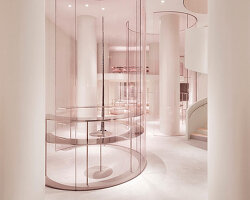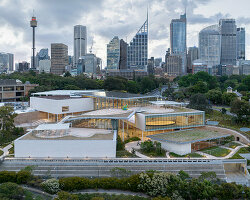
opening next week on monday 22 february, 2010 will be the rolex learning center designed by internationally acclaimed japanese architectural practice SANAA, led by kazuyo sejima and ryue nishizawa. built on the campus of EPFL ecole polytechnique fédérale de lausanne, the rolex learning center will function as a laboratory for learning, a library with 500,000 volumes and an international cultural hub, open to both students and the public.spread over one single fluid space of 20,000 sq metres, it provides a seamless network of services, libraries, information gathering, social spaces, spaces to study, restaurants, cafes and beautiful outdoor spaces. It is a highly innovative building, with gentle slopes and terraces, undulating around a series of internal ʻpatiosʼ, with almost invisible supports for its complex curving roof, which required completely new methods of construction.

located centrally on the EPFL campus, and its new hub, the building is essentially one continuous structure spread over a site of 88,000m2: the building is rectangular in plan, but appears to be more organic in shape because of the way that its roof and floor undulate gently, always in parallel. with few visible supports, the building touches the ground lightly, leaving an expanse of open space beneath which draws people from all sides towards a central entrance.
inside, the hills, valleys and plateaus formed by the undulation often make the edges of the building invisible, though there are no visual barriers between one area and the next. instead of steps and staircases, there are gentle slopes and terraces. clearly, but without dividing walls, one area of activity gives way to another. visitors stroll up the gentle curves, or perhaps move around the space on one of the specially designed ʻhorizontal liftsʼ, elegant glass boxes, whose engineering is adapted from everyday lift design.

as well as providing social areas and an impressive auditorium, the building lends itself to the establishment of quiet zones and silent zones, acoustically separated areas created through changes in height. the slopes, valleys and plateaus within the building, as well as the shapes made by the patios, all contribute to these barrier-free delineations of space. in addition, clusters of glazed or walled ʻbubblesʼ make small enclosures for small groups to meet or work together in.
the topography lends an extraordinary fluidity to the buildingʼs flexible open plan – a flow that is emphasised by fourteen voids in the structure, of varying dimensions. these are glazed and create a series of softly rounded external ʻpatiosʼ, as the architects describe them. the patios are social spaces and provide a visual link between the inside and the outside. they are very much part of the building.

from the higher areas, visitors may enjoy views not only of the campus but, spectacularly, of lake geneva and the alps. with all its unity and variety, the rolex learning center is, as described by kazuyo sejima on the announcement that SANAA had won the architectural competition, an ʻintimate public spaceʼ. the rolex learning center embodies the aims and philosophy of the EPFL, setting the scene for different kinds of collaborative, cross-disciplinary research, regarded as essential to advances in science and technology. It offers flexibility to use the building in many different ways, now and in the future, to absorb new technology and working methods, as they come on stream, many of them developed within EPFL itself. the building emphasises sociability, getting together for coffee, for lunch, for study, for seminars, to stimulate informal encounters between people of all the key disciplines. it is designed to be a landmark, a place people will want to visit, allowing EPFL to reach out to the surrounding community and internationally.
the engineering and construction of the rolex learning center is highly experimental and innovative. for the 3-dimensional curved concrete shells, SANAA worked with structural engineer, SAPS, to find the shapes with the least bending stresses by making computer simulations. after repeating this process numerous times, engineers bollinger und grohmann and walther mory maier made detailed calculations to arrive at the final shape. for the construction, SANAA worked closely with the total service contractor, losinger construction, on the final calculations and physical implementation of such large and gentle slopes. the concrete execution had to be precise because of the complex facade system that needed to absorb both the concrete shell deflection movement and the construction tolerances. one example of precise execution was the use of laser-cut 2.5m x 2.5m wooden formwork, which was positioned using GPS technology on site. for the ventilation and heating, the undulating one-room volume was also studied via computer simulation to determine the periods when natural ventilation was possible and when floor heating would be necessary. this helped to achieve a low energy consumption target.

essentially, the building is made up of two ʻshellsʼ. inside the two shells are 11 under-stressed arches. the smaller shell sits on four arches, 30-40 metres long, while the larger shell rests on seven arches, 55-90 metres long. the arches are held by 70 underground pre-stressed cables. the main structural materials are steel and wood, with concrete poured into formwork so precise that the underside of the building looks polished. the floor is a concrete structure, the roof steel and wood; the floor and roof run parallel to each other. to follow the geometry of the shells required 1400 different moulds for concrete. the concrete pouring involved delivering concrete continuously over a period of two days, to achieve the complex task of creating one continuous flowing roofspace. as the building is made up of a single structure, all the elements, including the roof, have to be flexible, to accommodate minute changes in dimension caused by natural and structural movements. the internal ceilings are jointed to accommodate these shifts. the curved glass facades, including those that wrap around the patios, with a total area of 4800 m2, also have to take the movement of the concrete: each piece of glass is cut separately, and each piece moves independently on jointed frames.
the rolex learning center is a highly energy-efficient building which, for its low energy consumption, has received the coveted minergie label – the standard used in switzerland for measuring environmental excellence in buildings. the building is largely daylit with carefully controlled natural ventilation systems, except for the restaurant and multimedia library, which have cold ceilings. it achieves a 38.5 kWh/m2 (139 MJ/m2) energy consumption thanks to high quality double-glazed windows, 20cm of insulation in the roof and up to 35 cm in the ground, exterior blinds, natural lighting and ventilation, and because it takes advantage of the 25-year-old installation of thermal pumps that use lake water for cooling the whole campus. this degree of energy efficiency was achieved by the pioneering engineering firm sorane SA, based near to the campus and comprised of engineers from lausanne and zurich. using digital modelling for airflow, lighting, and thermal measurements, the firm increased the energy efficiency of the new building to a technical maximum while at the same time ensuring the safety of its users in case of a fire. obtaining the minergie label is an even more outstanding achievement given the energy challenges of an open plan building.

project info:
name of building: rolex learning center
location: EPFL (ecole polytechnique fédérale de lausanne) 1015 lausanne, switzerland
schedule competition: 2004
construction: 2007 – 2009
opening: february 22, 2010
construction cost: 110 million CHF
client: epfl (ecole polytechnique fédérale de lausanne)
project leadership: patrick aebischer, president of EPFL, francis-luc perret, vice-president for planning and logistics of EPFL vincent joliat, project manager
architect: kazuyo sejima + ryue nishizawa / SANAA
team: yumiko yamada, rikiya yamamoto, osamu kato, naoto noguchi, mizuko kaji, takayuki hasegawa, louis-antoine grego
(former staff: tetsuo kondo, matthias haertel, catarina canas)
total service contractor: losinger construction sa bussigny, switzerland
commercial phase: bernard chauvet, directeur délégué agence valdo-genevoise
construction phase: eric maïno, directeur exploitation, cédric luce, chef de service adjoint
project management: botta management group AG, baar, switzerland — charles r. botta, president, CEO; pierre eller, project manager
local architect: architram SA renens, switzerland — françois vuillomenet, associate; dominik buxtorf, associate
structural base concept: saps / sasaki and partners tokyo, japan — mutsuro sasaki, ayumi isozaki, hirotoshi komatsu, hideaki hamada
structural engineer: B+G ingenieure bollinger und grohmann gmbh, frankfurt am main, germany — manfred grohmann, agnes weilandt, walther mory maier
bauingenieure ag münchenstein, switzerland; rene walther, gilbert santini; bg ingénieurs conseils sa lausanne, switzerland — michel capron; losinger construction sa bussigny, switzerland — jean-benoit leroux
mechanical: enerconom ag
hvac engineer: bern, switzerland — rolf moser
electrical engineer: scherler ingénieurs-conseils sa lausanne, switzerland — jacques mühlestein
façade consultant: emmer pfenninger partner ag münchenstein, switzerland — steffi neubert
energy concept: sorane sa ecublens, switzerland — pierre jaboyedoff
acoustic consultant: ecoacoustique sa lausanne, switzerland — victor desarnaulds
security consultant: bg ingénieurs conseils sa lausanne, switzerland
thierry visin and measurement, control consulting energy control sa
regulation: (mcr) plan-les-ouates, switzerland — michaël briffaz
geotechnical services: karakas & français sa lausanne, switzerland; christian voit; surveyor truffer-renaud-burnand sàrl renens, switzerland — daniel meier
building details:
site dimensions: 88,000 sqm (166.5m x 121.5m)
footprint: 20,200 sqm
floor area: 37,000 sqm
number of floors: 1 basement + 1 main
main programs multimedia library: 500,000 volumes; student workspaces – 860 seats; multipurpose hall ‘forum rolex’ – 600 seats; café + bar – 53 seats + exterior; food court – 128 seats + exterior; restaurant – 80 seats; career center; library staff office; EPFL precious book collection; student association office – ‘agepoly’; alumni association office – ‘a3’; pedagogy research office – ‘craft’; publication office – ‘ppur’; bank – ‘credit suisse’; bookshop – ‘la fontaine’; parking – 500 places
structure civil works, including foundation and piles: losinger construction sa (bussigny, switzerland)
concrete for ‘shell’ provided by: holcim sa, (bussigny, switzerland)
pre-stressed cables: freyssinet sa (moudon, swizerland)
roof steel beams, columns, braces: sottas sa (bulle, switzerland)
roof wood beams: ducret-orges sa (orges, switzerland)
technical electrical: ep electricité sa (genève, switerland)
electrical: etablissements techniques fragnière sa (bulle, switzerland)
ventilation and measurements, controls, regulation: consortium alvazzi /atel (crissier, switzerland)
floor heating: baruchli sa (lausanne, switzerland)
sanitary, plumbing: riedo clima sa (bulle, switzerland)
architectural lighting on main level: zumtobel lumière sa (romanelsur- lausanne, switzerland)
exterior glass façade system with anodized aluminum facia and sun protection box: roschmann konstruktionen aus stahl und glas gmbh (gersthofen, germany)
louver sun protection: warema schweiz gmbh (littau, switzerland) sika sarnafil flexible waterproof membrane
roof surface: pilatus flachdach ag (samstagern, switzerland)
concrete walkway covers: losinger construction sa (bussigny, switzerland)
interior screed: lirom chapes sa (le landeron, switzerland)
carpet flooring: interior services sa – pfister (etoy, switzerland)
baswaphon mineral plaster acoustic ceiling: clément peinture sa (fribourg, switzerland)
plasterboard + paint on ‘bubbles’: duca sa (cheseaux-sur- lausanne, switzerland)
expanded metal partitions: r. morand & fils sa (la tour-de-trême, switzerland)
steel railings with polycarbonate, or expanded metal infill: r. morand & fils sa (la tour-de-trême, switzerland)
curved glass for credit suisse and flat glass for meeting rooms: glas trösch ag (bützberg,switzerland)
inclined elevator: weiermann systems ag (wynigen, switzerland)
furniture information desks in anodized aluminum + acrylic: actoform sa (ecublens, switzerland)
anodized aluminum library bookshelves with lamps: unifor spa (turate, italy)
student work tables with lamps: developed by schoch werkhaus ag (winterthur, switzerland)
glass precious books collection case: bodenmann j. sa (le brassus, switzerland)
SANAA flower chair: vitra ag (birsfelden, switzerland)
vitra office furniture: teo jakob tagliabue sa (geneva-carouge, switzerland)
fritz hansen tables and chairs: batiplus sa (lutry, switzerland)
















